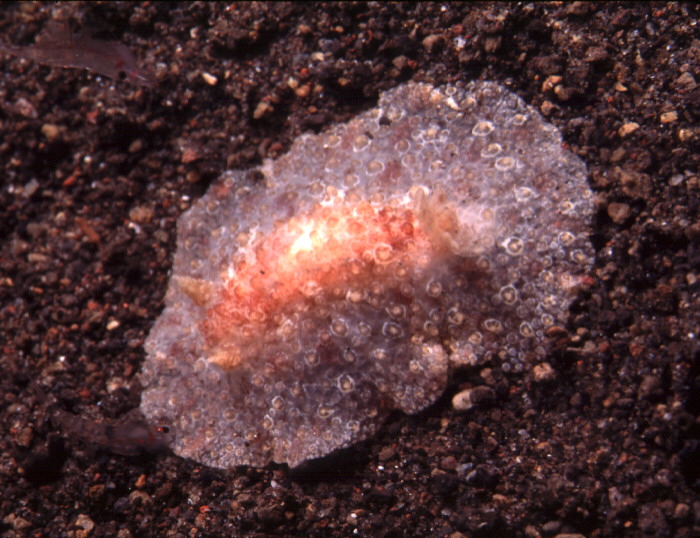 |
Hoplodoris sp.
Photo courtesy of Webmaster
Photograph taken at Tulamben, Bali, Indonesia in Oct. 2000
Hoplodoris sp. (Bergh, 1879)
The only reason we are calling this species of Hoplodoris from Tulamben, Indonesia, unidentified, is because it represents the problem this genus of crytobranch dorid presents divers and taxonomists. Since the description of the genus by Rudolph Bergh in 1880, several authors have wrestled with what to do with its individual species.
The genus, Hoplodoris is represented by a few described species and a bunch of critters like Mike's animal shown above, that do not easily fit any of the descriptions. A closely related genus,Carminodoris, is equally complicated, and being reviewed by one of our colleagues presently. This latter genus differs internally, by the lack of armature on the penis and vestibular glands. Described species of Hoplodoris include, Hoplodoris nodulosa (Angas, 1864) as presented on Bill Rudman's Sea Slug Forum and Hoplodoris estrelyado Gosliner & Behrens, 1998.
In Hoplodoris nodulosa, the mantle is densely pustulose, except medially, behind the rhinophores where the pustules are often absent or very reduced in size. The color is normally a mottled brown or yellowish brown. The median band is often a darker color than the rest of the mantle. Variations do occur widely in color.
In the more recently described Hoplodoris estrelyado, named by yours truly and good buddy, Terry Gosliner, the color pattern on the dorsal surface of this beast looks like fried eggs, served sunny-side up. Not only does the color look like a fried egg, but the tubercles covering the dorsal surface are tall and shaped like plump perfectly prepared fried eggs. The remainder of the dorsal surface is speckled with the white and black of scattered salt and pepper served with this dish. The rhinophores and gills are typically dorid in shape, and are dark brown with white specks.
Ever since webmaster Mike collected and photographed the first specimen of this new species in Batangas Province, our gang has referred to it as the Fried Eggs dorid. This eye catching pattern is the derivation of our nominated species name "estrelyado." Estrelyado is actually the Tagalog word for "sunny side up" which is derived from the Spanish word "estrella," for star, indicating the eggs are formed into star-like patterns with the yolk facing upwards.
The week's featured species (above) is almost identical to that species
shown as species # 186, page 114 in Atsushi Ono's Opisthobranchs of Kerama Islands. Ono's specimen, photographed at Zamami Island in Japan
is similar to Mike's Tulamben specimen in having thin white circles around
each dorsal pustules. Aside from a size of about 50 mm in length and their
occurrence on mucking bottoms, this species does not cleanly match either,
H. nodulosa or H. estrelyado, and will need to remain "unidentified" until
further notice.
Danville, Calif
Feb. 2001
Taxonomic information courtesy of Dave Behrens

David W. Behrens
Author:
Pacific Coast Nudibranchs
Send Dave mail at seachalleng@earthlink.net
|
